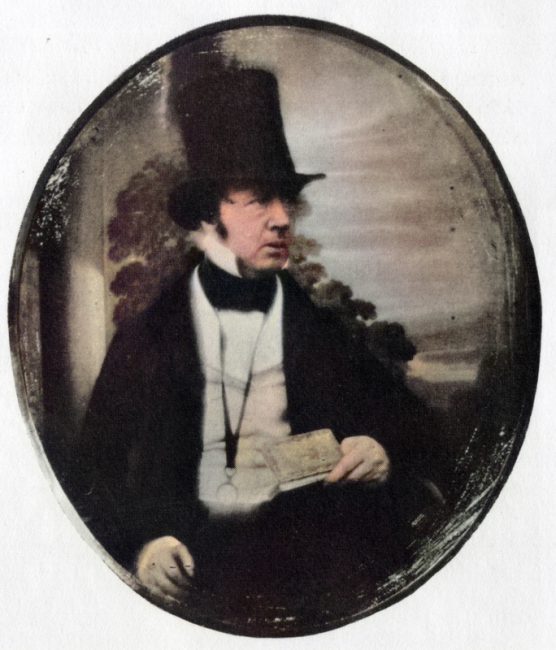
Henry Fox Talbot (1800-1877), photo by Antoine Claudet (1844), colors by [13]
On February 11, 1800, Henry Fox Talbot, British inventor and photography pioneer was born, who invented the calotype process, a precursor to photographic processes of the 19th and 20th centuries. Like other pioneers of early photography, Talbot not only was occupied with the processing technology, but also is known as an photographic artist. Moreover, Talbot‘s talents also extended to mathematics, astronomy, and archaeology. Actually, he even participated in the translation of the cuneiform inscriptions from Nineveh.#
“[The camera] may be said to make a picture of whatever it sees, the object glass is the eye of the instrument—the sensitive paper may be compared to the retina. “
— John Fox Talbot, 1839
Henry Fox Talbot – Youth and Education
William Henry Fox Talbot was born as an only-child in Melbury, Dorset, into a well-connected family. His father William Davenport Talbot died when he was only five months old and he and his mother Elisabeth Theresa Fox-Strangways lived in a succession of homes until she remarried Captain Charles Feilding (he was later promoted to a Rear-Admiral) in 1804, who was a devoted step-father to Henry. In 1810 Henry went to Harrow school where he remained until 1815 after which his preparation for university was completed with two years private tuition at home. He entered Trinity College, Cambridge, in 1817 and graduated in 1821. He was elected a Fellow of the newly founded Royal Astronomical Society in 1822 and worked hard at mathematical research but also enjoyed himself travelling widely on the Continent.
Meeting Sir John Herschel and David Brewster
In 1824, Talbot met Sir John Herschel by chance in Munich, and established a friendship and a scientific collaboration crucial to Talbot’s later success and probably influenced Talbot’s turn towards research into light and optical phenomena. In 1826, Herschel introduced him to David Brewster, the Scottish scientist and encyclopedist, whose research on light frequently overlapped with Talbot’s. Brewster began publishing Talbot’s scientific articles in his journal and the two men forged an unusually close and lifelong friendship. On 20 December 1832, he married Constance Mundy of Markeaton in Derbyshire and almost simultaneously, he was elected to Whig (reformist) Parliament as the reform candidate for Chippenham.
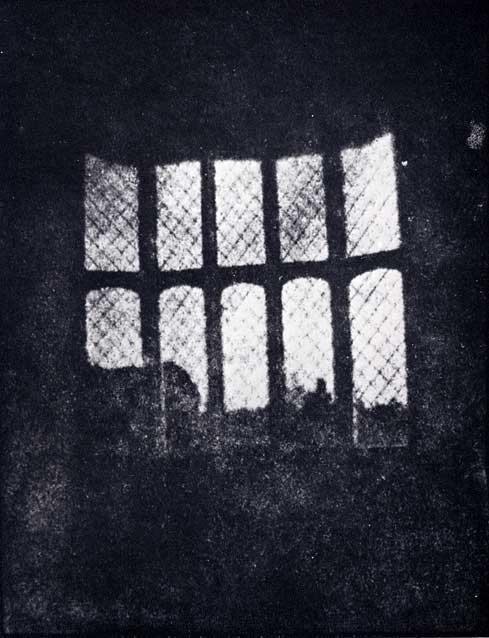
Latticed window at Lacock Abbey, August 1835. A positive from what may be the oldest existing camera negative
Photographic Experiments
According to his own account, Talbot started his photographic experiments beginning in early 1834, well before 1839, when Louis Daguerre [11] exhibited his pictures taken by the sun. After Daguerre’s discovery was announced, Talbot showed his five-year-old pictures at the Royal Institution on 25 January 1839. Within a fortnight, he freely communicated the technical details of his photogenic drawing process to the Royal Society. In 1841, Talbot announced his discovery of the calotype, or talbotype, process. This process reflected the work of many predecessors, most notably John Herschel and Thomas Wedgwood.[10] Talbot’s original contributions included the concept of a negative from which many positive prints can be made (although the terms negative and positive were coined by Herschel), and the use of gallic acid for developing the latent image. Talbot called his photographic images calotype, from the Greek for”beautiful.”
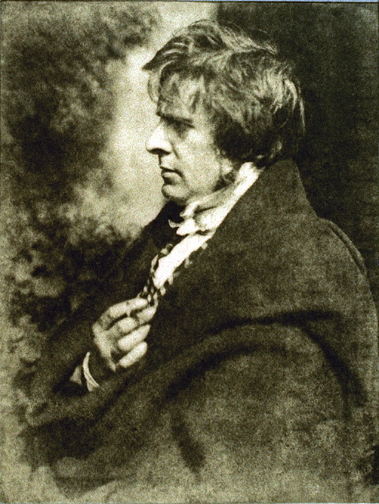
Portrait of David Octavius Hill (1802–1870), Scottish artist and photographer
The Basis of Modern Photography
“The plates of the present work are impressed by the agency of Light alone, without any aid whatsoever from the artists’ pencil.”
— John Fox Talbot, Epigraph, 1844, The Pencil of Nature
This method of converting a negative to a positive is the basis for modern photography. Unlike the calotype, Daguerre’s process could not produce multiple prints of an image. But Talbot’s photographs had a grainy quality and could not compare with the brilliant, minutely detailed silvered plates produced by Daguerre. In 1842, for his photographic discoveries detailed later in his The Pencil of Nature (1844-46), he received the Rumford Medal of the Royal Society. Talbot’s The Pencil of Nature, published in six installments, was the first book with photographic illustrations. Its 24 (of a proposed 50) plates document the beginnings of photography primarily through studies of art objects and architecture. In less than a decade, Talbot conceived and brought about a wholly new way of making pictures, perfected the optical and chemical aspects of photography, and learned to use the new medium to make complex images for the botanist, historian, traveler, and artist.
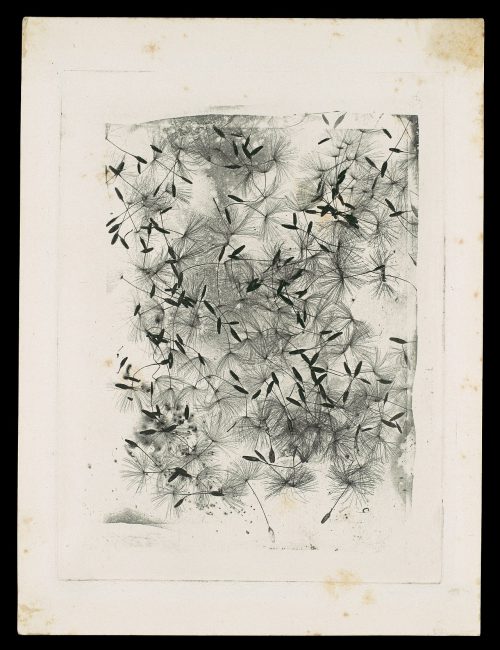
Dandelion Seeds (1858 or after 1858), Medium photogravure (photoglyphic engraving from a copper plate)
Licensing and Later Life
When Talbot received his patent for the calotype process in 1841, he first sold individual patent licences for £20 each, but later he lowered the fee to £4 and waived the payment for those who wished to use the process only as amateurs. Professional photographers, however, had to pay up to £300 annually. In a business climate where many patent holders were attacked for enforcing their rights, Talbot’s behaviour was widely criticized, especially after 1851 when Frederick Scott Archer publicized the collodion process and Talbot declared that anyone using Archer’s process would still be liable to get a license for calotype. Talbot spent the last twenty-five years of his life developing and perfecting an effective photogravure process. He died in his study at Lacock Abbey aged 77 on September 17, 1877.
Richard Ovenden, Hans P. Kraus, Larry J. Schaaf, Fox Talbot and His Legacy, [14]
References and Further Reading:
- [1] Henry Fox Talbot at bbc.com
- [2] William Henry Fox Talbot (1800–1877) and the Invention of Photography at met museum.org
- [3] Henry Fox Talbot: The Pencil of Nature at gutenberg.org
- [4] The Fox Talbot Museum
- [5] O’Connor, John J.; Robertson, Edmund F.: “Henry Fox Talbot“, MacTutor History of Mathematics archive, University of St Andrews.
- [6] Richard Leach Maddox revolutionized Photography, SciHi Blog, August 4, 2017
- [7] Alfred Stieglitz and Photography as Art, SciHi Blog, July 13, 2017
- [8] James Clerk Maxwell and the very first Colour Photograph, SciHi Blog, May 17, 2016
- [9] Henry Fox-Talbot at Wikidata
- [10] John Herschel – a Pioneer in Celestial Photography, SciHi Blog, March 7, 2016.
- [11] Making Photography Really Operational – Louis Daguerre, SciHi Blog, August 19, 2013.
- [12] Timeline of pioneers of photography born before 1825, via Wikidata
- [13] DeepAI Image Colorization API
- [14] Richard Ovenden, Hans P. Kraus, Larry J. Schaaf, Fox Talbot and His Legacy, Photo London Fair @ youtube

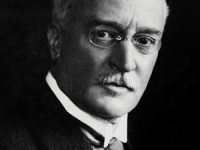


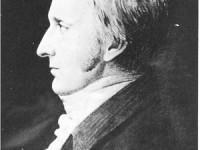

Pingback: Whewell’s Gazette Year 2, Vol. #31 | Whewell's Ghost
Pingback: LA – Delving Deeper into the History of Photography – BERGLJOT STØER
Pingback: History of Photography – In Short
Pingback: LT – The Development of the Camera part 1 – Miriam K